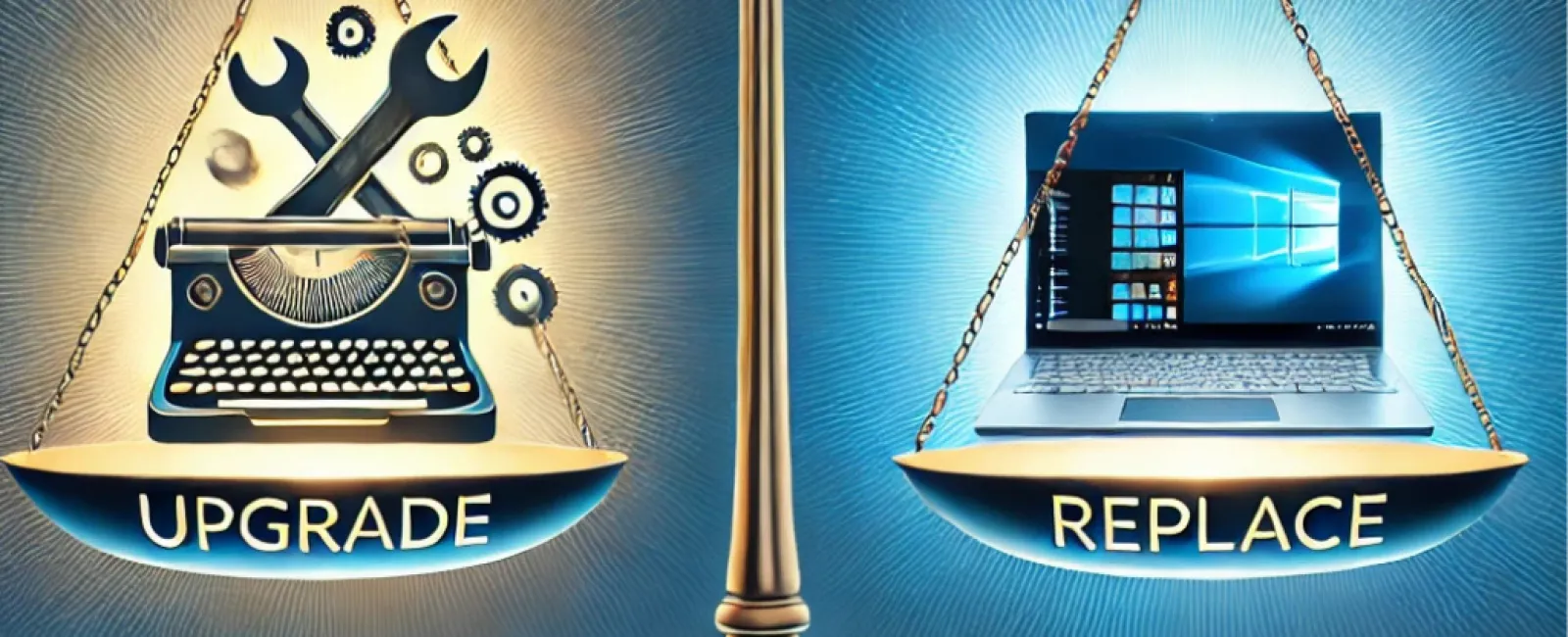March 11, 2025
Windows 10 End-of-Life: Should Your Business Upgrade or Replace?
Windows 10 support officially ends in October 2025, leaving businesses at a crossroads:
Upgrade existing devices to Windows 11 or replace them with new hardware?
Making the wrong move could impact security, compliance, and productivity—so let's break down the best strategy for your business.
Step 1: Check If Your Hardware Supports Windows 11
Before deciding, check if your current hardware meets Windows 11's strict system requirements:
✔ A compatible 64-bit processor (1 GHz+ with 2+ cores)
✔ 4 GB RAM minimum (8 GB+ recommended for business use)
✔ 64 GB storage (with room for updates)
✔ TPM 2.0 chip (Trusted Platform Module for advanced security)
How to Check Compatibility:
🔍 Use Microsoft's PC Health Check tool for a quick assessment.
📌 Review device specs manually in Settings > System > About.
🚨 If your devices fail the test, upgrading may not be an option—you may need new hardware.
Step 2: Evaluate Your Device's Age & Performance
Windows 11 is designed for modern, secure, high-performance computing. If your hardware is more than five years old, it might not support the new security and efficiency features.
Signs It's Time to Replace, Not Upgrade:
🔴 Frequent crashes, slow performance, or lagging apps
🔴 Incompatible hardware (especially no TPM 2.0)
🔴 Outdated firmware creating security vulnerabilities
🔴 Higher IT support costs due to frequent issues
👨💻 Pro Tip: Businesses relying on outdated systems spend more on IT maintenance and security risks than they would on a smart upgrade plan.
Step 3: Upgrade or Replace? Weighing Cost vs. Value
Cost is always a factor, but long-term efficiency and security should drive your decision.
| Option | Pros | Cons |
|---|---|---|
| Upgrade Existing Devices | Lower upfront cost (if compatible) | May require extra upgrades (RAM, SSD) |
| Replace with New Devices | Faster, more efficient hardware | Higher initial cost, but better ROI |
⏳ The Cost of Waiting: If your outdated hardware is slowing down workflows, you're already losing money in lost productivity and IT issues.
Step 4: Security & Compliance Risks of Delaying
Once Windows 10 reaches end-of-life in October 2025, Microsoft will stop releasing security updates, making your business vulnerable to:
⚠️ Cyberattacks (ransomware, phishing, data breaches)
⚠️ Compliance failures (HIPAA, CCPA, SOC 2 regulations)
⚠️ Software incompatibility (new business apps may not support Windows 10)
For businesses handling sensitive client data, staying on Windows 10 could increase liability risks.
🚀 Solution: Upgrading or replacing ensures ongoing security, compliance, and performance.
Step 5: Future-Proofing Your Business with Windows 11
Investing in modern devices now helps future-proof your business for scalability and efficiency.
Benefits of Upgrading to Windows 11:
✔ Stronger cybersecurity (built-in protections & hardware encryption)
✔ Faster, more efficient processors (reduce employee downtime)
✔ Energy-efficient devices (lower power costs & sustainability benefits)
✔ Seamless compatibility with modern business applications
🛑 Avoid last-minute decisions. Planning ahead ensures a smooth transition before the October 2025 deadline.
The Smartest Way to Upgrade? Partner with Simplicity IT
Making the wrong choice between upgrading or replacing could cost your business time, money, and security.
At Simplicity IT, we help small businesses maximize their IT investment with expert hardware assessments, cybersecurity solutions, and IT cost optimization.
📊 Get a FREE Windows 11 Upgrade Assessment
✅ Find out if your current hardware is Windows 11 ready
✅ Get expert recommendations on upgrade vs replace
✅ Ensure compliance, security, and smooth transition
🔗 Click here to book your FREE IT Assessment!
Final Thoughts: Don't Wait Until It's Too Late
The Windows 10 end-of-life deadline is approaching fast. Businesses that delay may struggle with security risks, compliance fines, and performance issues.
Act now to protect your business and keep operations running smoothly.

